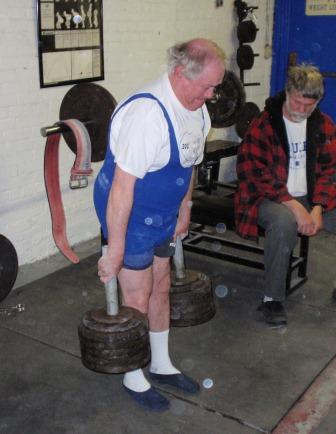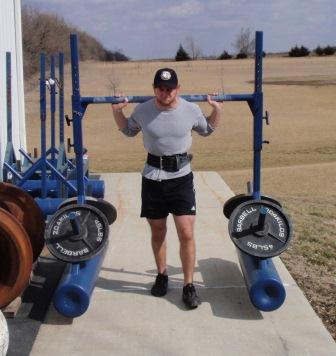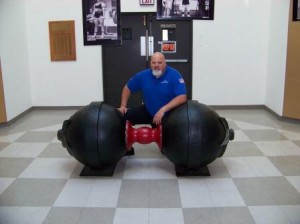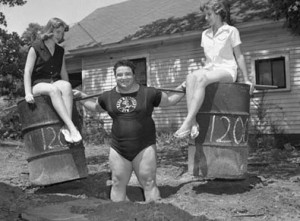by Al Myers

Longtime USAWA member and IAWA supporter John McKean performs a 283 pound Vertical Bar Deadlift - 2 Bars, 2" at the 2010 USAWA Club Challenge in Ambridge, PA.
One of the lifts that will be contested at this year’s World Championships in Perth, Australia will be the Vertical Bar Deadlift, 2 Bars, 2″. This a very difficult grip lift that requires grip strength in BOTH HANDS. If one of your hands is weaker than the other, this lift will show it! I have done this lift in several USAWA competitions to date, but never in an IAWA competition. This event was contested at the 2003 USAWA National Championships in Youngstown, Ohio.
A while back I received a question regarding this lift which I thought was an EXCELLENT QUESTION, so I would like share this question and my response since I’m sure other lifters might be wondering the same thing.
QUESTION: I wonder if you could help me out with some lifting technique!? It is with reference to the 2 x 2″ vertical bar lift for Australia – I had a go at this lift on friday night, I attempted it with one bar at either side of my legs and found the weight plates were catching my legs all the way up!!! Is the straddle stance, i.e. one pin in front and one pin behind a legal position? Also is it mechanically better? Thanks for the help.
First, lets do a review of the rules for this lift. By now most of you know my frustrations with the nuances of rule differences between the USAWA rules and the IAWA rules for lifts. Well, this lift is no exception to that as you will see. (By the way, both of these rule descriptions are actually for the same lift! It doesn’t appear that way when you read them. ) Even the names are drastically different – the USAWA calls it a deadlift while the IAWA rules just call it a lift.
USAWA Rules for the Vertical Bar Deadlift, 2 Bars, 2″
I25. Vertical Bar Deadlift – 2 Bars, 2”
The rules of the Vertical Bar Deadlift – 2 Bars, 1” apply except two 2” inch diameter Vertical Bars are used.
Need to reference this rule –
I24. Vertical Bar Deadlift – 2 Bars, 1”
The setup for this lift requires two Vertical Bars, which is a bar of one inch diameter with a maximum length of 18 inches. A collar or plate must be tightly fastened or welded to the bottom so plates may be added to the bars. Both vertical bars must be loaded to the same weight. No knurling is allowed on the bars. The lifter must start with the bars on each side of the lifter. Width of feet placement is optional, but the feet must be parallel and in line with the torso. Feet must not move during the lift, but the heels and toes may rise. Each bar may be gripped by any grip near the top of the Vertical Bars. The forearms are not allowed to touch the bars. The lifting hands or weight may accidentally touch the lifter’s body or legs during the lift, provided that it does not aid in the lift. The lift begins at the lifter’s discretion. The body must then straighten, lifting the Vertical Bars from the platform. The legs must be straight and knees locked and the body upright at the completion of the lift. Any rotation of the bars must be completely stopped. Once the weight is motionless, an official will give a command to end the lift.
IAWA Rules for the Two Vertical Bars (one in each hand) – 2 inch rods
F26. TWO VERTICAL BARS (ONE IN EACH HAND) – 2 INCH RODS
The rules of performance are the same as for the vertical bar lift, except that the lift is performed with two x 2 inch diameter bars / rods, one in each hand.
Causes for Failure:
1. Causes for failure are the same as for the vertical bar lift, except that 2 x 2 inch rods are used.
Need to reference this rule –
F19. VERTICAL BAR LIFT – TWO INCH ROD
The rules of performance are the same as for the vertical bar lift, except that the lift is performed with a two inch diameter bar / rod.
Causes for Failure:
1. Causes for failure are the same as for the one hand vertical lift, except that a 2 inch rod is used.
Need to reference this rule as well –
F2. ONE HAND VERTICAL BAR LIFT
The lifter will grip a vertical bar with one hand, and lift the bar and weight stack clear of the lifting surface, holding it motionless and under control for two seconds. On completion the legs should be erect and straight with the free hand clear of any contact with the body. The bar will be of 1 inch diameter, and can be up to 30 inches long. A collar or base plate should be tightened or welded on the bottom to hold the vertical weight stack. The bar should not be knurled. The lifter can use an optional grip, and the lifting hand should not be in contact with or in close proximity to the weight stack, so as to avoid any tipping or gripping of the bar with the weight stack at an angle. The lifter should also be careful to ensure that the bar does not touch the forearm or leg, and the lifting hand is not locked against the thigh.
Causes for Failure:
1. Any contact of the bar with the forearm or legs, or locking of the lifting hand or bar against the thigh.
2. Any contact between the lifting hand and the weight stack, or any attempt to tip or grip the bar at an angle.
3. Failure to achieve and maintain the finished position (weight held clear of the lifting surface, motionless and under control for two seconds, with the legs erect and straight and the free hand clear of any contact with the body.
4. Replacing / lowering the bar before the referees signal.
Wow! That is confusing – isn’t it??? Now add in the factor that the World Entry form, in it’s attached list of guidelines for the rules of the lifts to be contested, has this lift misnamed as the 2 HANDS FULTON DUMBELLS DEADLIFT (I’m sure this is was just listed this way on accident), but you can see why someone would have questions regarding this lift! Add in the differences in rules between the USAWA and the IAWA and it makes it nearly impossible for me to answer some parts of the question as well.
Is the straddle stance legal?
The USAWA rules state that it IS NOT (the bars must be on each side of the lifter). The IAWA rules don’t state that is an infraction (nothing is mentioned regarding the lifter’s stance) , so I can assume that a straddle stance is allowed. Now to the part about it being a mechanically advantage to use the straddle stance – I have tried it both ways and I prefer the side by side approach. It seems to me that my grip is dramatically reduced when holding one of the VBs to the back, and since this event is limited by my grip and not my back strength, this reduces the amount I can lift.
What are some other rules differences between the USAWA and the IAWA?
The big one that “jumps out” to me is the legal length allowed. The USAWA rules clearly state the VBs can not be over 18 inches in length while the IAWA rules allow a length of up to 30 inches long! This is a HUGE difference! Having a VB that long turns this lift into a partial lift. For some short lifters, the VB may barely even clear the floor at lockout! The USAWA rules require the lifter to stand totally upright with shoulders back (that is why it is called a deadlift in the USAWA rules) while the IAWA rules only require, as stated in the rules “to lift the bar and weight stack clear of the lifting surface”, thus I would say is why it is just called a lift. Nothing is stated in the IAWA rules about being required to stand upright (but I won’t be surprised that this will be required come meet day, and be justified with the explanation that standing upright was implied). Here’s another question – my left hand strength on a VB is slightly less than my right hand, so can I load the VBs to different weights? The USAWA rules clearly state NO on this – but this is not stated as an infraction in the IAWA rules so I’m going to assume I can do this (but then again I bet come meet day this will also not be allowed, with the explanation that this is ANOTHER implied IAWA rule on this lift). With these rule differences it appears to me that the USAWA rules are much more difficult than the IAWA rules for this SAME LIFT. There is one rule issue that might make the IAWA rules a little more difficult than the USAWA rules as they state the weight must be “motionless and under control for two seconds” whereas the USAWA rules only require the VBs to be held till “the weight is motionless”. Two seconds is a long time to hold at lockout after becoming motionless, and will definitely decrease the amount of weight that can be lifted versus getting the down command immediately when the VBs are motionless.
Neither set of rules state limitations on the size of plates that can be loaded onto the Vertical Bars. When lifting the VBs at your side, large plates (45#s or 20Ks) will hit the side of your legs and cause drag, and in turn less weight can be lifted. I prefer loading the VBs with smaller plates(25#s or 10Ks) when performing this lift. Hopefully this will be the way the Vertical Bars will be loaded in Australia.
I have stated my opinion on rules many times before but I’m going to repeat it. I don’t really care WHAT the rules are for a lift as long as the rules are well written and are specific in what is allowed and disallowed. NOTHING SHOULD BE IMPLIED WHEN IT COMES TO THE RULE BOOK.
It also would be nice if the USAWA and the IAWA had consistent rules in all of the lifts. We are far from that now. But if at Worlds, the Vertical Bars are 30 inches long and only need to clear the floor a 1/2″ to be a legal lift, I will adapt to that and do it that way!






